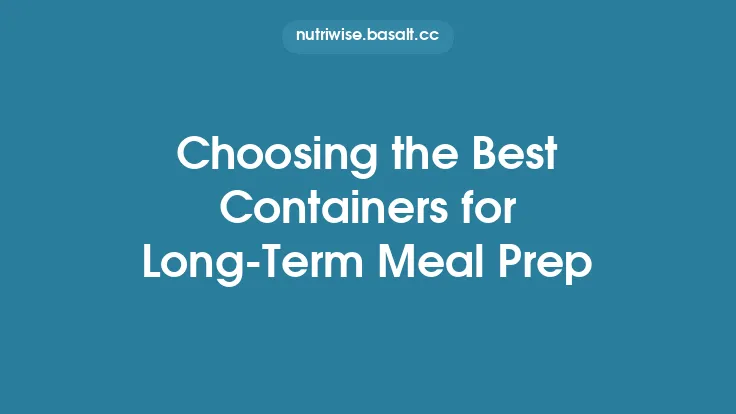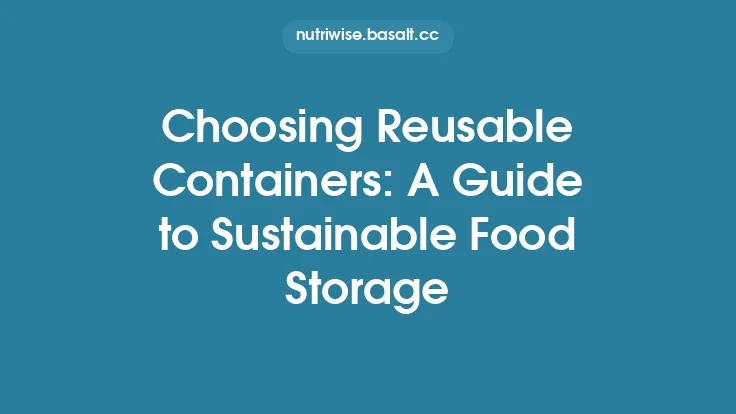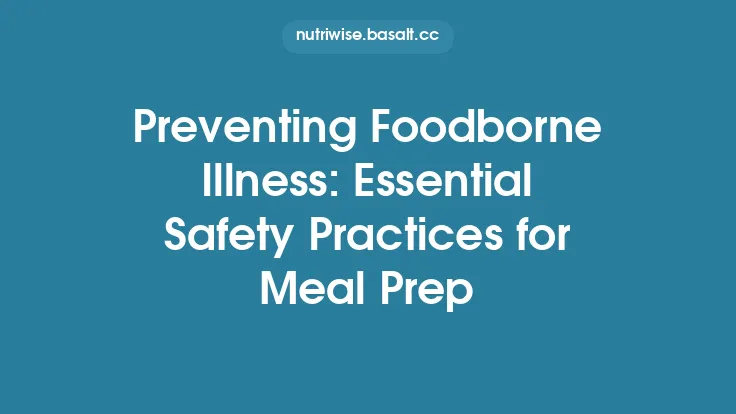Meal prepping is a powerful way to streamline your week, but the real magic happens when the food you’ve carefully assembled stays safe and delicious until you’re ready to eat it. While the act of cooking is only half the battle, the way you store those meals determines whether they retain their quality, nutritional value, and, most importantly, their safety. This guide dives deep into the underlying principles that keep your pre‑made dishes stable, explores practical techniques you can apply in any kitchen, and equips you with the tools to monitor and maintain optimal storage conditions over days or weeks.
The Science Behind Food Preservation
Understanding why food spoils is the first step toward preventing it. Four key variables dictate microbial activity and chemical change:
| Variable | How It Affects Food | Typical Control Methods |
|---|---|---|
| pH (Acidity) | Most bacteria thrive near neutral pH (6.5‑7.5). Lower pH (more acidic) slows or halts growth. | Adding citrus juice, vinegar, or fermented ingredients; using acid‑based marinades. |
| Water Activity (a<sub>w</sub>) | Water is the medium for enzymatic reactions and microbial metabolism. Reducing a<sub>w</sub> limits these processes. | Drying, adding salt or sugar, incorporating humectants like glycerol, or using high‑moisture‑absorbing packaging. |
| Oxygen Availability | Aerobic microbes (e.g., molds, many spoilage bacteria) need oxygen. | Using low‑permeability films, creating modified atmospheres, or employing oxygen‑absorbing packets. |
| Temperature | Every microorganism has a “danger zone” where it multiplies fastest (roughly 4 °C–60 °C). | Rapid cooling, maintaining consistent cold storage, and avoiding temperature fluctuations. |
By manipulating these factors, you can create an environment where spoilage organisms are either unable to grow or are forced into a dormant state.
Controlling Moisture: Reducing Water Activity
Moisture is often the silent culprit behind soggy textures and rapid spoilage. Here are proven strategies to keep water activity in check without compromising flavor:
- Salt and Sugar Brining
Both solutes bind free water, lowering a<sub>w</sub>. A light brine (1‑2 % salt) for vegetables or a sugar glaze for fruit‑based dishes can extend stability while adding subtle taste layers.
- Incorporating Humectants
Ingredients such as glycerol, sorbitol, or honey attract water molecules, effectively “locking” them away from microbes. A teaspoon of glycerol per cup of sauce can make a noticeable difference.
- Dry‑Packing Techniques
When storing salads or grain bowls, keep dry components (e.g., nuts, seeds, croutons) in separate, airtight compartments. This prevents moisture migration that would otherwise raise a<sub>w</sub> in the entire container.
- Paper Towels and Food‑Safe Mats
Placing a thin layer of paper towel beneath or atop a dish absorbs excess surface moisture. For longer storage, replace the towel every 24‑48 hours.
Managing Oxygen Exposure Without Vacuum Sealing
While vacuum sealing is a popular method, there are alternative ways to limit oxygen that are equally effective for many meal‑prep scenarios:
- Barrier Films
Multi‑layer polyethylene‑nylon or EVOH (ethylene‑vinyl alcohol) films have low oxygen transmission rates. Wrapping dishes tightly in these films creates a quasi‑anaerobic environment.
- Oxygen‑Absorbing Sachets
Small packets containing iron powder, activated carbon, or ascorbic acid can be placed inside containers. They chemically bind residual oxygen, extending shelf stability.
- Modified Atmosphere Packaging (MAP) Lite
For home use, a simple method involves flushing a container with a gas mixture (e.g., nitrogen or carbon dioxide) using a kitchen‑grade gas canister and a valve. Even a brief purge can displace enough oxygen to slow aerobic spoilage.
- Layered Storage
Placing a sheet of parchment or wax paper directly on the food surface before sealing reduces the exposed area, limiting oxygen diffusion.
Temperature Management Beyond the Fridge: Rapid Cooling Techniques
Even if you avoid detailed temperature charts, the principle remains: the faster you bring cooked food from the “hot” zone to the “cold” zone, the less time microbes have to multiply. Here are practical, equipment‑light methods:
- Ice‑Water Bath (Ice‑Slug Method)
Fill a large bowl with ice and water, submerge sealed bags or heat‑proof containers, and stir gently. This can drop the temperature of a 500 ml portion from 80 °C to below 10 °C within 10‑15 minutes.
- Metal or Stone Cooling Plates
Pre‑chill a stainless‑steel sheet or a marble slab, then spread the hot food thinly across it. The high thermal conductivity of metal or stone accelerates heat loss dramatically.
- Portion‑Size Cooling
Divide a large batch into smaller, shallow containers before cooling. A thinner layer loses heat faster than a deep pot, reducing overall cooling time.
- Staggered Transfer
Move food from the cooking vessel to a secondary container (e.g., a glass bowl) as soon as it reaches a safe handling temperature (≈70 °C). The secondary container, being at room temperature, will absorb heat more quickly.
Harnessing Natural Preservatives and Fermentation
Beyond physical controls, biochemical approaches can add an extra safety buffer:
- Acidification
Adding a modest amount of citric acid or lactic acid to sauces and dressings drops pH, creating an inhospitable environment for many pathogens.
- Fermented Condiments
Incorporating kimchi juice, sauerkraut brine, or miso into marinades introduces beneficial lactic acid bacteria that outcompete spoilage organisms.
- Spice Antimicrobials
Certain spices—such as rosemary, thyme, oregano, and clove—contain phenolic compounds with antimicrobial properties. A teaspoon of dried herb blend per liter of broth can modestly extend stability.
- Enzyme Inhibitors
Ascorbic acid (vitamin C) not only lowers pH but also slows oxidative browning in fruits and vegetables, preserving both appearance and nutrient integrity.
Packaging Strategies That Support Safety (Without Focusing on Container Choice)
While the type of container is a separate discussion, the way you use packaging can dramatically affect safety:
- Seal Integrity Checks
After sealing, press the lid or film to ensure no air pockets remain. A simple “bubble test” (pressing a finger on the surface) can reveal hidden gaps.
- Layered Barriers
Combine a moisture‑absorbing packet with an oxygen‑absorbing packet inside the same container. This dual approach tackles both a<sub>w</sub> and oxygen simultaneously.
- Transparent vs. Opaque
Light can accelerate oxidation in fats and pigments. For fatty dishes (e.g., pesto, nut‑based sauces), store in opaque containers or wrap in foil to limit light exposure.
- Flexible vs. Rigid
Flexible pouches conform to the food’s shape, reducing trapped air pockets. Rigid containers can be advantageous for stacking but may trap more air if not packed tightly.
Monitoring and Verifying Storage Conditions
Even the best techniques can falter without verification. Simple tools help you stay confident that your meals remain within safe parameters:
- Digital Thermometers with Probe
Insert the probe into the thickest part of a dish to confirm it has reached the target cooling temperature before sealing.
- Data Loggers
Small, battery‑powered devices record temperature over time. Place one in a batch of meals to detect any unexpected temperature spikes during transport or storage.
- pH Strips or Meters
For acidic preparations, a quick pH check ensures the intended acidity level was achieved, providing an extra safety check.
- Moisture Indicator Cards
These cards change color when humidity exceeds a set threshold, alerting you to potential condensation issues inside containers.
Common Pitfalls and How to Avoid Them
| Pitfall | Why It Happens | Quick Fix |
|---|---|---|
| Storing Hot Food Directly in the Fridge | Heat raises the internal temperature of the fridge, creating a temporary “danger zone.” | Cool food using an ice‑water bath or spread it thinly before refrigerating. |
| Over‑Packing Containers | Limited headspace prevents proper sealing and traps steam, raising a<sub>w</sub>. | Leave a small gap (≈1 cm) at the top before sealing; use flexible packaging to conform to the food’s shape. |
| Neglecting Moisture Barriers | Condensation forms on lids, creating a wet environment that encourages spoilage. | Place a paper towel or silicone mat between food and lid; use moisture‑absorbing packets. |
| Re‑Sealing After Opening Without Refreshing the Atmosphere | Re‑introduction of oxygen can reignite aerobic spoilage. | Replace the lid or film with a fresh barrier after each use, or use a fresh oxygen‑absorbing packet. |
| Mixing Fresh and Aged Meals in the Same Drawer | Heat from newer meals can raise the temperature of older, already‑stable meals. | Store newly prepared items on a separate shelf or in a distinct compartment until they have fully cooled. |
Building a Sustainable Storage Routine
Consistency is the cornerstone of long‑term success. Here’s a step‑by‑step workflow you can adopt each week:
- Plan the Cooling Phase
Allocate 15‑20 minutes after cooking for rapid cooling using one of the methods above. Set a timer to avoid forgetting.
- Prep Packaging Materials
Have barrier films, moisture‑absorbing packets, and oxygen‑absorbing sachets pre‑cut and ready. This reduces handling time and ensures you don’t skip a step.
- Apply Preservative Enhancements
Add a pinch of acid, a dash of spice blend, or a spoonful of fermented juice while the food is still warm, allowing even distribution.
- Seal and Verify
Close the container, perform the seal integrity check, and, if possible, record the internal temperature with a probe.
- Label with a Simple System (optional, but not a focus)
Even a quick handwritten note with the preparation date helps you track turnover without a full labeling protocol.
- Store in a Dedicated Zone
Reserve a specific shelf or drawer for meal‑prep items. This minimizes accidental temperature fluctuations caused by frequent door openings.
- Weekly Audit
Use a data logger or a simple thermometer to confirm that the storage zone remains within the desired temperature range. Replace any compromised packets.
By embedding these steps into your weekly routine, you turn safe storage from a one‑off task into an automatic part of your meal‑prep workflow.
Closing Thoughts
Safe food storage is less about memorizing a checklist and more about mastering the underlying principles that govern microbial growth and chemical change. By controlling acidity, water activity, oxygen exposure, and temperature—while leveraging natural preservatives and smart packaging—you create a robust barrier against spoilage. Coupled with simple monitoring tools and a repeatable routine, these strategies ensure that the meals you invest time in preparing remain nutritious, flavorful, and, most importantly, safe to enjoy throughout the week.





